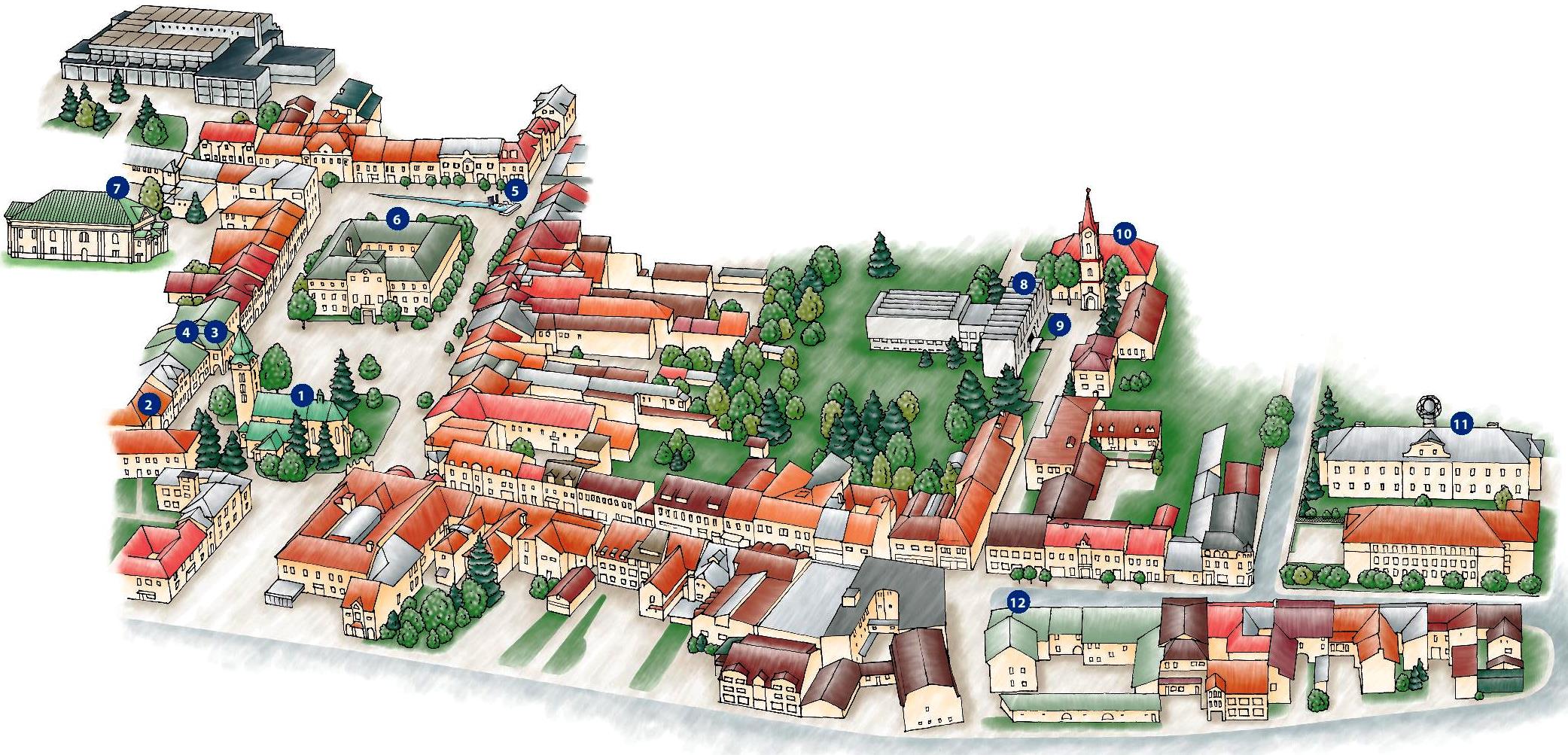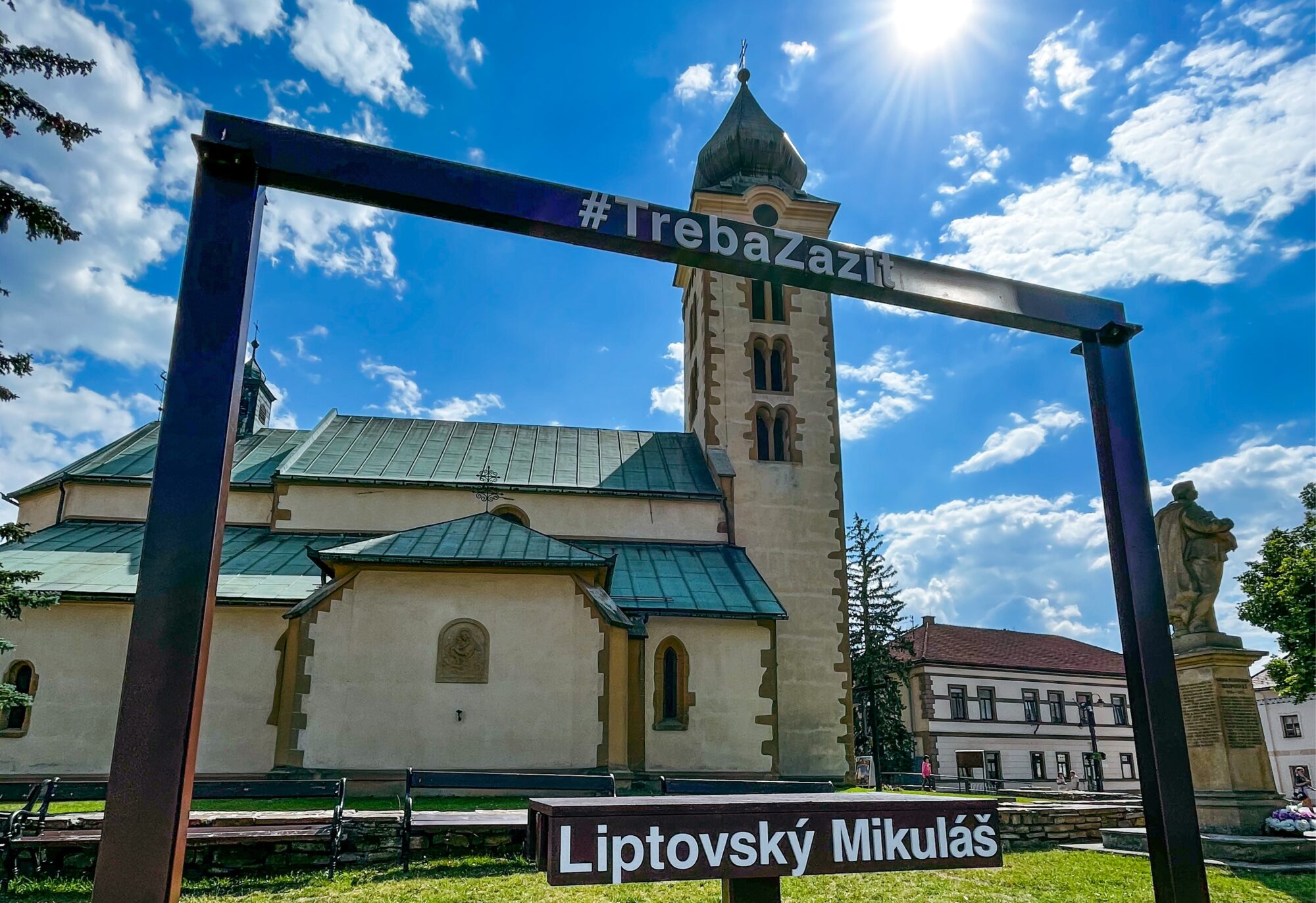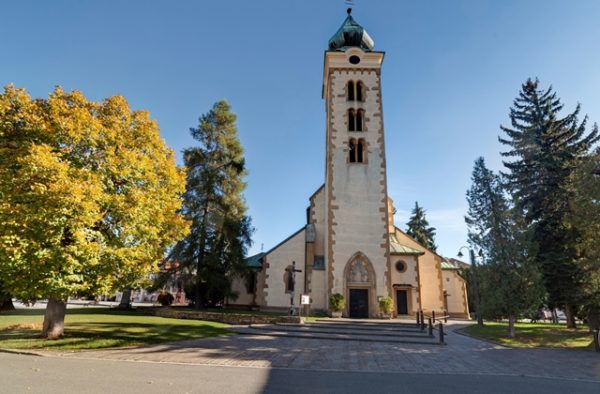The most attractive place in Liptovský Mikuláš is the historic center. It offers its TOP 12 to its visitors. 12 interesting places with connection to the rich history, present, famous personalities or works of art.

See the gems of the oldest architectural monument in the city – the largest early Gothic building in Liptov!
It was built as a parish church for 5 nearby settlements. At first, he stood alone in the middle of the country, gradually the town of St. Nicholas grew around him. This impressive sacral building stands on the site of an older Romanesque church from the 11th – 12th centuries, which took over the role of the sacristy during the construction of the single-nave church in the years 1280 – 1300 and is the oldest part of the present church. In the middle of the 15th century, the church was enlarged and vaulted, the tower was built and modified in the late Gothic style. At that time, the church, together with the nearby Pongrác manor, was fortified and surrounded by a moat; it later underwent a baroque reconstruction. In 1941 – 1943 it was reconstructed again, the fortification wall was removed and side chapels were added. Subsequently, beautiful stained glass windows were installed.
The gallery presents the largest collection of works by an excellent graphic artist, a native of Koloman Sokol, whose work was also appreciated by Pablo Picasso.
The Koloman Sokol Gallery has been housed in the historic Pongrác manor on the main square since 2002. It was opened on the occasion of the 100th birthday of an important Slovak graphic artist and painter, a native of St. Nicholas Koloman Sokol (1902 – 2003). In 2017, the name was changed to the Koloman Sokol Gallery and the permanent exhibition of Koloman Sokol, the founder of Slovak and Mexican graphics, was reinstalled.
The basis of the permanent exhibition became 48 top works, which the artist dedicated to his native country. The collection of graphics and drawings is complemented by Sokol’s biography, personal objects and images by the renowned Slovak photographer Tibor Huszár, which were created during his visit to Master Sokol in the United States. On the first floor of the oldest secular building in the city, you can get to know not only the unique artistic expression of Koloman Sokol but also his dramatic life story. The exhibition hall on the ground floor of the gallery gives space to personalities of Slovak graphics, new names in Slovak art, but also to foreign artists.
In the historical premises of the First Capital House, you will get to know the seven-century-old story of Liptovský Mikuláš. Its most important milestones will guide you through the exhibition Chapters from the History of the City. An extraordinary event was the trial of the immortal bandit captain Juraj Jánošík. His destiny will come to life in front of you in Jánošík’s torture chamber and courtroom. Also visit the newly opened Jánošík Garden and the Postal Pigeon exhibition. Other important moments and personalities from the history of the city are captured in the expositions of the museum located outside its main building – the majestic synagogue, the Birth House of the Rázus siblings and the exposition of the Tatrín and the Requests of the Slovak Nation.
More information HERE
The Janko Kráľ Museum hides one of the cruellest courts in the history of the town. In March 1713, the brigand captain Juraj Jánošík was imprisoned, interrogated, tortured and sentenced to death. You can learn how did the trial of legendary Jánošík take place in Jánošík´s Torture Chamber, which is hidden in the dark underground of the museum. Take a look at the rack, the nipper, the Spanish boot and the notes of his voluntary and bitter interrogation. They are witnessing the inhuman practices of the time when torture was a legal part of the trial. In Jánošík´s Courtroom, which realistically depicts the courts of the time, you can dress in period costumes and become a judge, advocate or Jánošík himself.
More information HERE
The Fountain of Metamorphosis with the names of famous natives immortalized in dark granite is the most photographed place in the pedestrian zone. The place of honor belongs to the inventor, professor, founder of the theory of steam and gas turbines Aurel Stodol, who was greatly respected by Albert Einstein himself.
The fountain is dominated by the monument-Tribute to Creative Thinking. Blocks with rotating mirror surfaces symbolize the constant transformation and movement, the infinity of the passage of time, thoughts, ideas and new changes, as well as the imaginary turbine blades of a modern machine. The lower static parts bear the names of seventy St. Nicholas natives – scientists, inventors, artists, writers, priests, doctors – who have been permanently recorded in history. The area around the fountain is a popular resting place with many cafes and patisseries.
The fountain is located in the historic city center on the north side of the Liberators Square.
The largest building in the middle of the square housed the county administration, once also the capital court and prison. The facade is decorated with a relief of the coat of arms of the Liptov capital, the staircase is illuminated by stained glass windows designed by Ester Šimerová-Martinčeková.
The building was built in the years 1778 – 1793 as the new seat of the Liptov capital. Its construction was carried out by the Banská Bystrica builder Peter Grossmann. It acquired its current appearance by reconstruction in 1907, when one floor was added. In the second half of the 20th century, the district national committee was based here, and today it is the seat of the district office.
The synagogue in Liptovský Mikuláš, built in the years 1842 – 1846 as a single-storey classicist building with a flat beamed ceiling and austere interior, is today one of the largest and most stylish in Slovakia. It acquired its current form after reconstruction in 1906, but the original building forms a substantial part of today’s synagogue – its outer shell. The Budapest architect, Leopold Baumhorn, built a structure from steel beams and columns into the existing foundation. The unique system of a steel net carrying a thin, only five-centimeter plaster shell allowed a relatively large three-aisle space to be vaulted and galleries for women to be built into the concept. Thanks to this innovative technical solution of the vault, which was less used at that time and in our environment, the St. Nicholas Synagogue is also one of the important monuments of a technical nature.
At the same time, it is proof of the architect’s ability to adapt the original building to new requirements with a sensitive change of disposition and at the same time respect for the original work. The author has achieved a harmony between the predominant classicist expression of the facade, while preserving the character of the original roof and the Art Nouveau character of the interior, including the dome with beautiful stained glass. The interior is dominated by rich blue-gold stucco decoration. The Art Nouveau character of the interior was completed by metal chandeliers and stained glass windows with floral theme.
The synagogue, restored thanks to the city’s investments and opened to the public in 1991, is now under the administration of the Janko Kráľ Museum. Inside this unique monument, the museum presents a solo exhibition dedicated to the history of the St. Nicholas Jewish community, installed in the western gallery. The synagogue hosts an annual Mosty-Gesharim concert with the participation of leading domestic and international artists.
The third oldest gallery in Slovakia has the largest exhibition hall among Slovak galleries and manages more than 5,000 works.
The Liptov Gallery of Petr Michal Bohúň was established in 1955 and is the third oldest in Slovakia. It is housed in a late 18th-century building, built for evangelical education. In its premises in the years 1854 – 1865, Peter Michal Bohúň, a painter of the national revival and a classic of Slovak fine art of the 19th century, worked as a teacher. Today’s modern form of the building acquired in the 70s of the 20th century. At present, you will find five permanent exhibitions and an exhibition hall in which large group, thematic, collective or author exhibitions are organized.
In its first part, the Old Art exhibition presents rare panel paintings and sculptures of High and Late Gothic from the area of northern Slovakia, but especially Liptov (Gothic altar from Dovalovo, altar parts from the Svätý Kríž ). The second part is a selection of Renaissance and Baroque paintings and sculptures. The painting of the 18th century is mainly represented by a period aristocratic portrait. The third part presents the so-called popular forms of Baroque – sculptural creation of domestic carving workshops of the 18th and 19th centuries.
Another permanent exhibition in a representative cross-section describes the development of Slovak painting in the 19th century entitled Portrait, Landscape, Genre. Portrait paintings (Czauczik, Klemens), but also landscape themes of the second half of the 19th century (E. Ballo, Medňanský, Skutecký, etc.) are represented here. The largest space is dedicated to the creative personality of Peter Michal Bohúň in an exhibition called Bohúň Hall. In the gallery you can admire up to 32 of his paintings. The collection is complemented by works from the beginning of the 20th century, which by their nature, in the way of artistic expression of spices in the previous century (Mousson, A. Ballo, Kubínyi, Halász-Hradil, Kyselý, P. J. Kern, early Mallý and Benko’s works, etc.).
Visitors, who are more interested in modern art, will certainly not miss the exhibition dedicated to the Slovak fine arts of the 20th century – Modern – 20th century. The permanent exhibition describes the development of Slovak painting in the first half of the 20th century. There is a representation of the founding generation of modern Slovak art, which draws on themes from the rural environment, later also the urban and intimate environment. These are painters influenced by Art Nouveau, symbolism, expressionism (Zolo Palugyay, Anton Jasusch, Edmund Gwerk), artists with overlaps with European modernism (Ľudovít Fulla, Mikuláš Galanda, I. Weiner Kráľ), members of the so-called Generations 1909 (Ján Mudroch, Ján Želibský, Ladislav Čemický, Ester. Š. Martinčeková) and others.
The fifth exhibition is an exhibition of works by personalities of the fine arts of Liptov. It presents four important artists who linked their lives and work with Liptov and the city in its heart, and their significance far exceeded the borders of the region and Slovakia. Their names speak for themselves: Ester Martinčeková-Šimerová, Martin Martinček, Miroslav Ksandr and Michal Kern.
The statue Our Mother (1896) is registered in the Louvre in Paris as a creation belonging to the most perfect statues in the world.
For many years, they sold the photo with its image in the USA, especially for Mother’s Day. The author is Alojz Štróbl, a native of Liptov and a leading figure in Hungarian sculpture. The statue depicts Štróbl’s mother as the artist remembered her sitting in a chair with a bible in her lap sitting at a house in nearby Kráľova Lehota. The marble original of the statue is exhibited in the permanent exhibition of the Hungarian National Gallery in Budapest, in front of the gallery is its bronze casting.
The construction of the Evangelical Church in Liptovský Mikuláš was made possible by the Toleration Patent of Joseph II. from 1781, on the basis of which Protestants were already allowed to build brick churches, albeit outside the square, without a tower and bells. Evangelicals from 13 Liptov villages took part in its construction in the years 1783-1785. A simple classicist building without a tower has served the faithful for almost a hundred years when the city was hit by a devastating fire and damaged the rectory and the attic of the temple. During the restoration, a massive tower with a dignified entrance to the temple was added to its southern wall. The three-nave vaulted space has extensive emporiums above the side aisles, thanks to which the St. Nicholas Church with 1,700 seats is one of the largest evangelical churches in Slovakia. The interior with a classicist pulpit is dominated by a large late Baroque columnar altar with an extension and side tendril “ears”, which close the lower part in the shape of a circle. A unique organ in the Western Empire dates back to 1892.
The only museum of its kind in Slovakia with interactive expositions of the Kras and Caves of Slovakia and the protected nature of Slovakia with parts of the Earth-place for life and Man, NATURA 2000 mountains.
Slovak Museum of Nature Protection and Speleology – the most modern museum in Slovakia, the only specialized museum of its kind in Slovakia. On an area of approximately 1400 m2, you will find such unique exhibits as the skeleton of a cave lion, which is one of the largest in Europe, a prehistoric cult mask and a model of a meteorite.
You can see and experience the world of nature from the underground gradually to the high mountains. Unique exhibits are located in natural ecosystems. Of course, the museum does not lack interactivity, visitors have the opportunity to look into the bear’s lair or try crawling in a cave. The exhibits are complemented by light and sound effects, in which one feels as if he is really walking through the forest. You can hear, for example, the singing of birds, the whistling of marmots and the howling of wolves. In the attic of the museum you can get acquainted with various leisure and economic activities of man – beekeeping, fishing, shepherd, skiing, rescue in the mountains or enter Rainer’s shelter, the oldest cottage in the High Tatras.
The cave exposition with beautiful waterfalls is located in the basement of the building and offers a comprehensive picture of caves and caving. The visitor can see the origin and development of the cave, cave decoration, archaeological finds, historical attractions, but he will also get to know the work of the caver. Finally, we invite you to the lookout tower of the museum, from which you can see the landmarks of Liptovský Mikuláš and the beautiful panorama of the surrounding hills of the Low and Western Tatras, Choč Hills and Great Fatra.
The Liptov Museum NKP Čierny orol presents the most typical representatives of the fauna of the region in the exposition of hunting and fishing in Liptov.
The only permanent exposition of the Liptov Museum in Liptovský Mikuláš is open to the public in the premises of the national cultural monument Čierny orol. In the historical section, it maps the History of Hunting and Fishing in Liptov from the Middle Ages to the present. It presents basic knowledge about the fauna of the region, species of game and fish describes the development of organizational forms of hunting and fishing, important personalities from this area, but also the depiction of hunting and fishing by Liptov artists. The exposition includes demonstrations of game, various hunting equipment and a hunting salon furnished with period furniture. The museum also has another exhibition space in the building, which it uses to present short-term exhibitions.



Please describe your experience